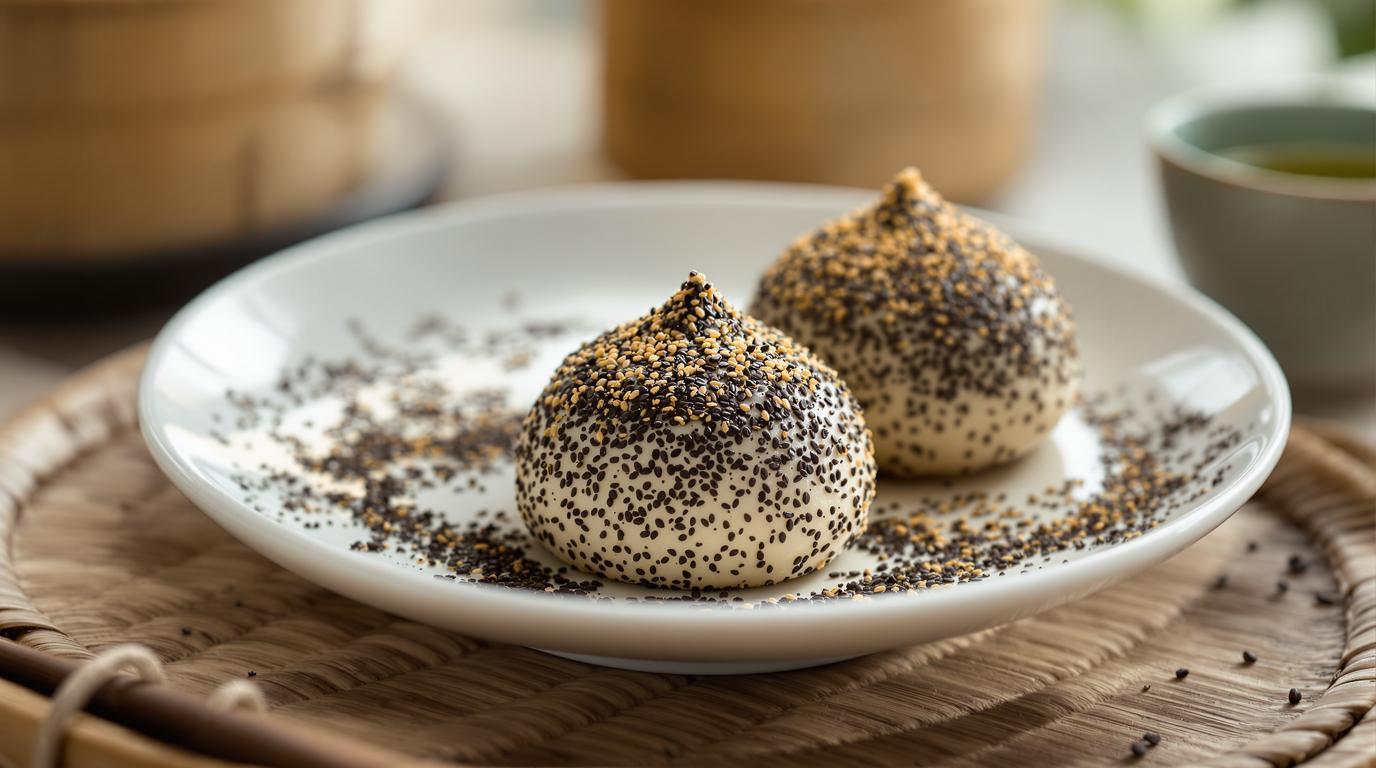There’s something transcendent about the pillowy softness of freshly made mochi. As a young apprentice in Tokyo, I watched in awe as my mentor’s grandmother transformed simple rice flour into cloud-like confections with nothing more than steam, patience, and decades of intuition. The gentle aroma of toasted black sesame—earthy, nutty, and slightly sweet—would fill her modest kitchen as she worked her magic. Today, I’m sharing my adaptation of her treasured black sesame mochi recipe, preserving the traditional steaming method that delivers that distinctive chewy texture that’s impossible to achieve any other way.
The Cultural Heritage of Black Sesame Mochi
Black sesame mochi beautifully represents the intersection of Chinese and Japanese culinary traditions. While Japanese versions often feature sweet fillings tucked inside a pillowy exterior (daifuku style), Chinese variations typically embrace a more textural experience with the mochi rolled in aromatic sesame-sugar mixtures. This recipe honors both traditions, offering the coating method with an optional filling variation.
As my mentor’s grandmother explained, “The true test of mochi isn’t just in the eating—it’s in the bounce.” A properly made mochi should spring back gently when pressed, signaling that perfect balance between firmness and yield that only comes from properly developed glutinous rice starches.
Essential Ingredients & Their Roles
The foundation of authentic mochi relies on remarkably few ingredients:
- 140g (1½ cups) glutinous rice flour – The non-negotiable star that gives mochi its signature chewiness
- 15g (2 tbsp) tapioca flour – Adds elasticity and prevents drying
- 20g (2 tbsp) granulated sugar – Just enough sweetness without overwhelming
- ⅛ tsp salt – The secret flavor enhancer
- 180ml (¾ cup) warm water – Temperature matters for proper hydration
- 40ml (3 tbsp) coconut milk – Contributes subtle richness and moisture
- 15ml (1 tbsp) neutral oil – Prevents sticking and adds tenderness
For the coating that transforms these treats:
- 50g black sesame powder – Fresh-ground delivers superior aroma
- 40g granulated sugar – Creates the perfect sweet-nutty balance
Chef’s Note: Can’t find black sesame powder? Toast 50g black sesame seeds in a dry pan until fragrant (about 2 minutes), then grind in a spice grinder until powdery. The fresh-ground aroma is worth the extra step!
The Traditional Steaming Method
While modern recipes often shortcut with microwaving, I urge you to embrace the traditional steaming method that grandmothers have relied on for generations:
- In a medium bowl, whisk together the glutinous rice flour, tapioca flour, sugar, and salt.
- Create a well in the center and pour in the warm water, coconut milk, and oil.
- Stir with a wooden spoon until a shaggy dough forms. Don’t worry if it seems slightly grainy at this stage.
- Transfer the mixture to a heat-proof bowl and cover tightly with foil.
- Place the bowl in a steamer over rapidly boiling water and steam for 15-20 minutes.
- The dough is ready when it becomes translucent and a wooden skewer inserted comes out clean.
The Critical Kneading Technique
This next step separates good mochi from exceptional mochi:
- Transfer the hot dough to a work surface dusted with a bit of cornstarch (don’t wait too long—it needs to be worked while warm).
- Knead with slightly dampened hands for about 2-3 minutes until smooth and elastic.
- The dough should be sticky but manageable—think of it as a living thing that changes texture as you work it.
- Divide into roughly 16 equal pieces (about 25g each).
Finishing with Tradition
- Combine the black sesame powder and sugar in a shallow bowl.
- While the mochi pieces are still slightly warm, gently roll each piece in the sesame-sugar mixture.
- Place on a serving plate, allowing slight space between pieces as they may stick together.
For those craving the Japanese daifuku experience, prepare a filling by combining 100g black sesame paste with 50g powdered sugar and 15g melted butter. Chill until firm, then wrap about 10g of filling inside each mochi piece before coating with the sesame-sugar mixture.
Serving & Cultural Context
In Japan, these treats would typically accompany a delicate cup of green tea, the slight bitterness perfectly balancing the sweet, nutty mochi. The contrast of textures—that distinctive mochi chew against the gentle crunch of the sesame coating—creates a sensory experience that has delighted generations.
Serve them within a few hours of making for the best texture, though they’ll keep covered at room temperature for a day. Any longer, and you’ll need to embrace the preservation techniques that our grandmothers perfected.
This black sesame mochi connects us to culinary traditions that span centuries. Much like learning to make proper gnocchi or mastering ancient flatbreads, these recipes remind us that sometimes the simplest ingredients yield the most profound pleasures when treated with respect and tradition.
As you enjoy these delicate morsels, you’re partaking in a culinary tradition as meaningful as Greek spoon sweets or Southern fried chicken—foods that nourish not just our bodies but our connection to the past. There’s wisdom in these old recipes, passed down through countless kitchens before finding their way to yours.
